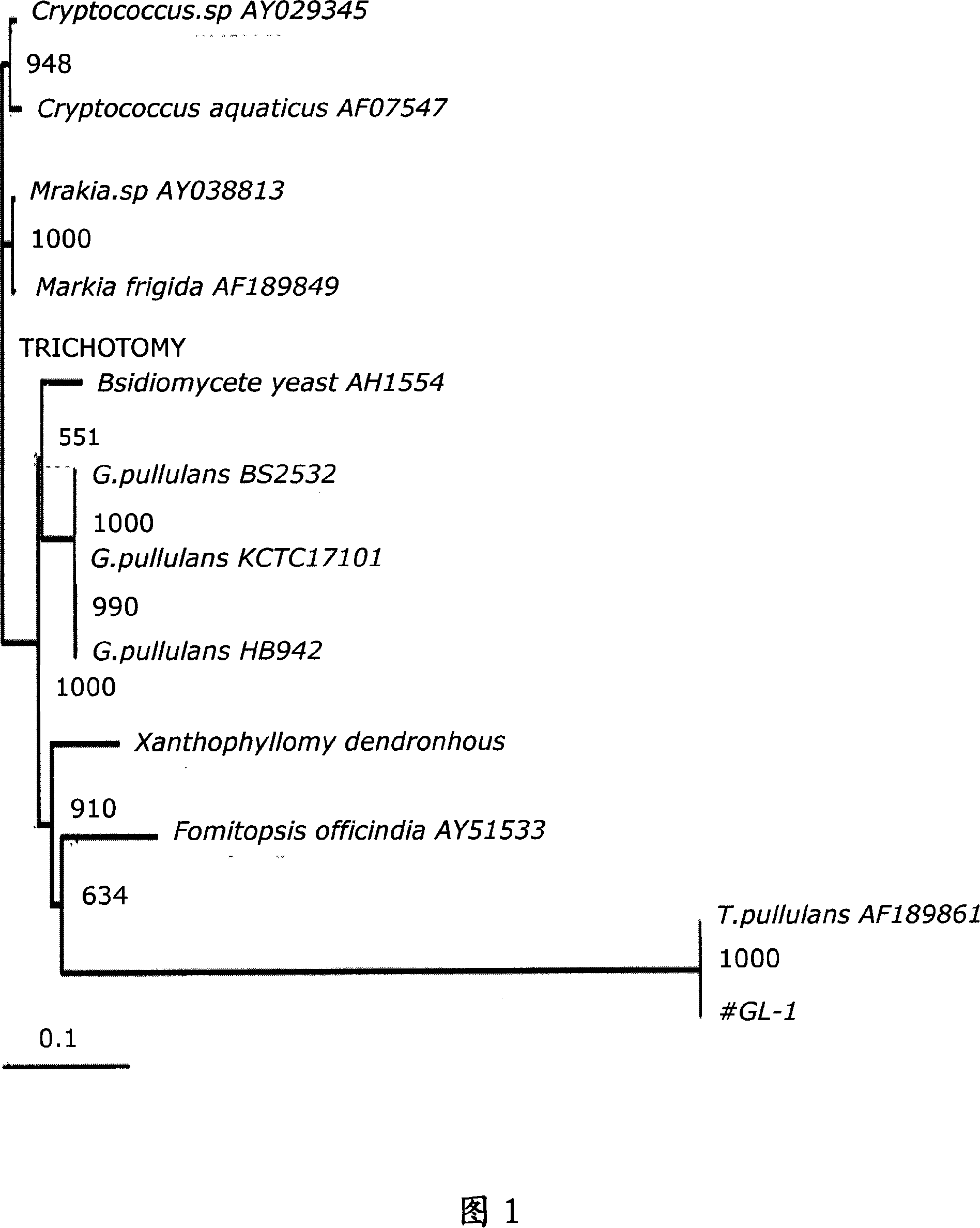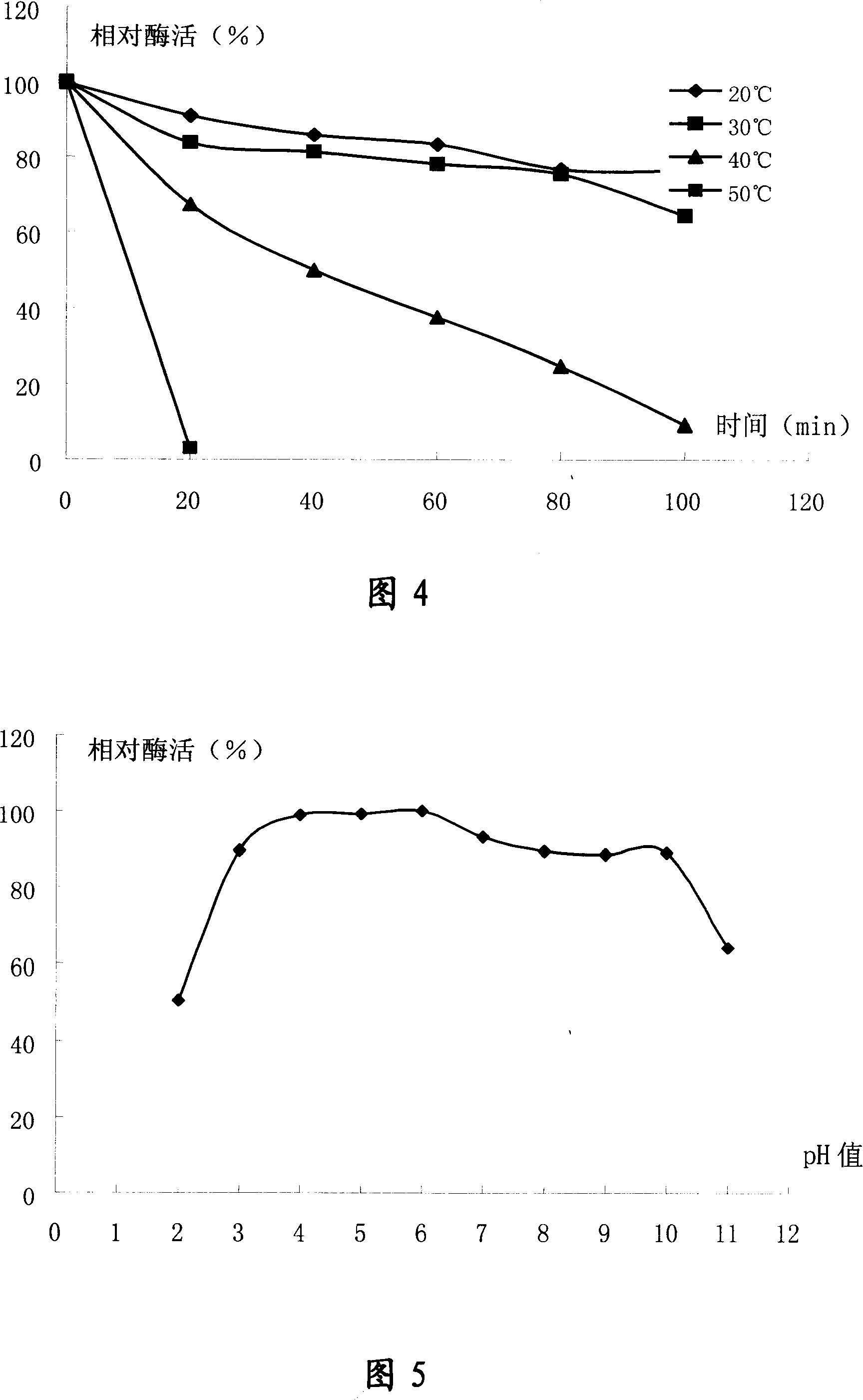Low-temperature lipase mycopremna, low-temperature lipase and method of preparing the same
A production method, lipase technology, applied in the direction of fungi, hydrolytic enzymes, etc.
- Summary
- Abstract
- Description
- Claims
- Application Information
AI Technical Summary
Problems solved by technology
Method used
Image
Examples
Embodiment 1
[0073] Embodiment 1: the cultivation-I of low-temperature lipase producing bacteria (GL-1)
[0074] The low-temperature lipase producing bacteria GL-1 of the present invention is inoculated in the fat assimilation plate medium, wherein (NH 4 ) 2 SO 4 0.1%;K 2 HPO 4 0.1%; NaCl0.05%; MgSO 4 ·7H 2 O 0.05%; FeSO 4 ·7H 2 O 0.001%; yeast extract 0.5%; agar 2.5%; natural pH; take olive oil and 2% polyvinyl alcohol (PVA) to mix in a ratio of 1:3, 10000r / min stirring and emulsifying for 5min, 0.8kg / cm 2 After sterilizing for 30 minutes, take 12ml and add it to 100ml of the above medium. After culturing at about 20°C for 5-7 days, a transparent circle can be formed around the colony of the low-temperature lipase-producing bacteria of the present invention.
Embodiment 2
[0075] Embodiment 2: Cultivation-II of low-temperature lipase-producing bacteria (GL-1)
[0076] Rhodamine B was prepared as a 0.05% mother solution, and added to the oil assimilation medium of Example 1 in an amount of 1.0%, to prepare a Rhodamine B chromogenic medium. When the low-temperature lipase-producing bacteria GL-1 of the present invention is inoculated in the above-mentioned culture medium, an orange-red halo will appear around the colonies of the low-temperature lipase-producing bacteria of the present invention, and red fluorescent circles will appear under ultraviolet light.
Embodiment 3
[0077] Embodiment 3: the fermentation culture of low-temperature lipase producing bacteria (GL-1 bacterial strain)
[0078] Insert the low-temperature lipase-producing bacteria of the present invention into the wort liquid seed medium, wherein malt extract powder 0.3; yeast extract 0.3; peptone 0.5; glucose 1.0; 1.0kg / cm 2 Steam sterilize for 15 minutes. After culturing at 20°C for 1-2 days, inoculate in the following fermentation medium with a 5% inoculation amount. Bean cake powder 2.0, corn syrup 2.0, glucose 1.0, K 2 HPO 4 0.5, NaNO 3 0.5, pH7.0, in 250ml Erlenmeyer flask, 50ml per bottle, 0.8kg / cm 2 Steam sterilize for 3O minutes. Shake culture at 20°C and 200rpm for 48h. After culturing, the bacterium is removed by centrifugation to obtain a low-temperature lipase crude enzyme liquid, and the fermented enzyme yield can reach 20 U / mL. Add ammonium sulfate to the lipase solution obtained in this way to make its saturation reach 60%, let it stand for precipitation to...
PUM
 Login to View More
Login to View More Abstract
Description
Claims
Application Information
 Login to View More
Login to View More - R&D
- Intellectual Property
- Life Sciences
- Materials
- Tech Scout
- Unparalleled Data Quality
- Higher Quality Content
- 60% Fewer Hallucinations
Browse by: Latest US Patents, China's latest patents, Technical Efficacy Thesaurus, Application Domain, Technology Topic, Popular Technical Reports.
© 2025 PatSnap. All rights reserved.Legal|Privacy policy|Modern Slavery Act Transparency Statement|Sitemap|About US| Contact US: help@patsnap.com



